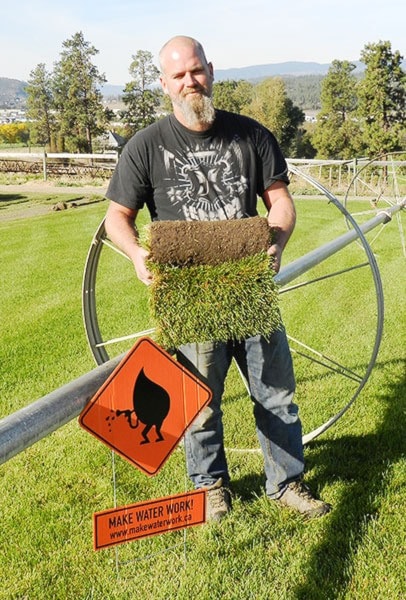With a forecast that the next six months will be the warmest on record, residents of the Okanagan are advised to prepare for at least another year of extremely dry weather by making landscape changes this fall so they can conserve water next season.
Fall is a good time to replace water-hungry turf by over-seeding or replacing existing lawn with drought tolerant turf or seed. One such product available in the Okanagan is Eco-Smart Blend, which requires 40 per cent less water than standard lawn grasses, advises Barry Paull, who owns Eco-Turf Farms in Kelowna.
Lawns are among the heaviest users of water in the landscape, so they’re a good place to begin in trying to conserve.
The sod is available until mid-November or freeze-up, says Paull, who explains that they switched from standard turf to this deep-rooted blend about three years ago in response to customer demand for a more WaterWise option.
When removing existing turf, replace it with a deep layer of good topsoil before replanting with water-conserving lawn. Roots of Eco-Turf can grow to 15 inches, compared to four to six inches for standard varieties, according to Paull.
Okanagan Xeriscape Association executive-director Gwen Steele suggests if you decide to put in plants instead of turf, begin by replacing just a portion of your existing lawn with drought-tolerant plants.
“Fall is a good time to plant because the air is cool, but the soil is still warm, which is ideal for roots to get established before frost. They’ll get started growing again as soon as the soil thaws in spring,” she notes.
As well, some perennials can be planted by seed in fall, including blanket-flower or gaillardia; rudbeckias; coreopsis and echinacea.
Autumn is also a good time of year to tinker with your plantings. Steele recommends you take a walk around your landscape and make notes on which plants did not do well in our hot, dry summer. There might be a better location where they would get a bit more water or shade. Remember to group plants with similar water needs.
For a listing of WaterWise plants that might do better in that location find the new Make Water Plant Collection, and a listing of local nurseries that carry the collection, at www.MakeWaterWork.ca/plants. The collection was created in partnership between the Okanagan Basin Water Board’s WaterWise program, OXA and Bylands Nurseries.
For more ideas, browse the extensive plant database on the OXA website (www.okanaganxeriscape.org) . You will also find a Landscape Assessment Tool there to help you reduce outdoor watering.
Steele is an enthusiastic fan of creating compost. Leaves that drop to the ground in fall are a perfect start. Small ones can be left where they fall, but large ones should be mowed or shredded first. But don’t use walnut leaves, she adds.
If you do decide to replace an existing thirsty lawn you can also smother it over winter in preparation for a colourful xeriscape landscape or drought-resistant lawn in spring. First, cut it very short, soak it well and cover it with wet cardboard. Mulch that with four inches of Ogogrow or well-rotted manure, or wood chips if you plan to put in just shrubs. Keep the area wet so the grass rots underneath over winter.
Then, do a test dig in spring to ensure the turf has rotted, before seeding or planting, advises Steele.
With 24 per cent of all Okanagan water used on household lawns and gardens, and less water available per person than anywhere in Canada, valley residents are encouraged to reduce outdoor water use this summer and fall. Take the pledge to Make Water Work at www.MakeWaterWork.ca.
Take the pledge to:
• Water plants. Not pavement.
• Water between dusk and dawn.
• Leave lawn 5-8 cm (2-3 inches) tall
• Leave grass clippings as mulch
• Top dress with compost; and
• Change out some lawn for drought-tolerant turf and/or native and low-water variety plants.
Make Water Work is an initiative of the Okanagan Basin Water Board and its Okanagan WaterWise program.
